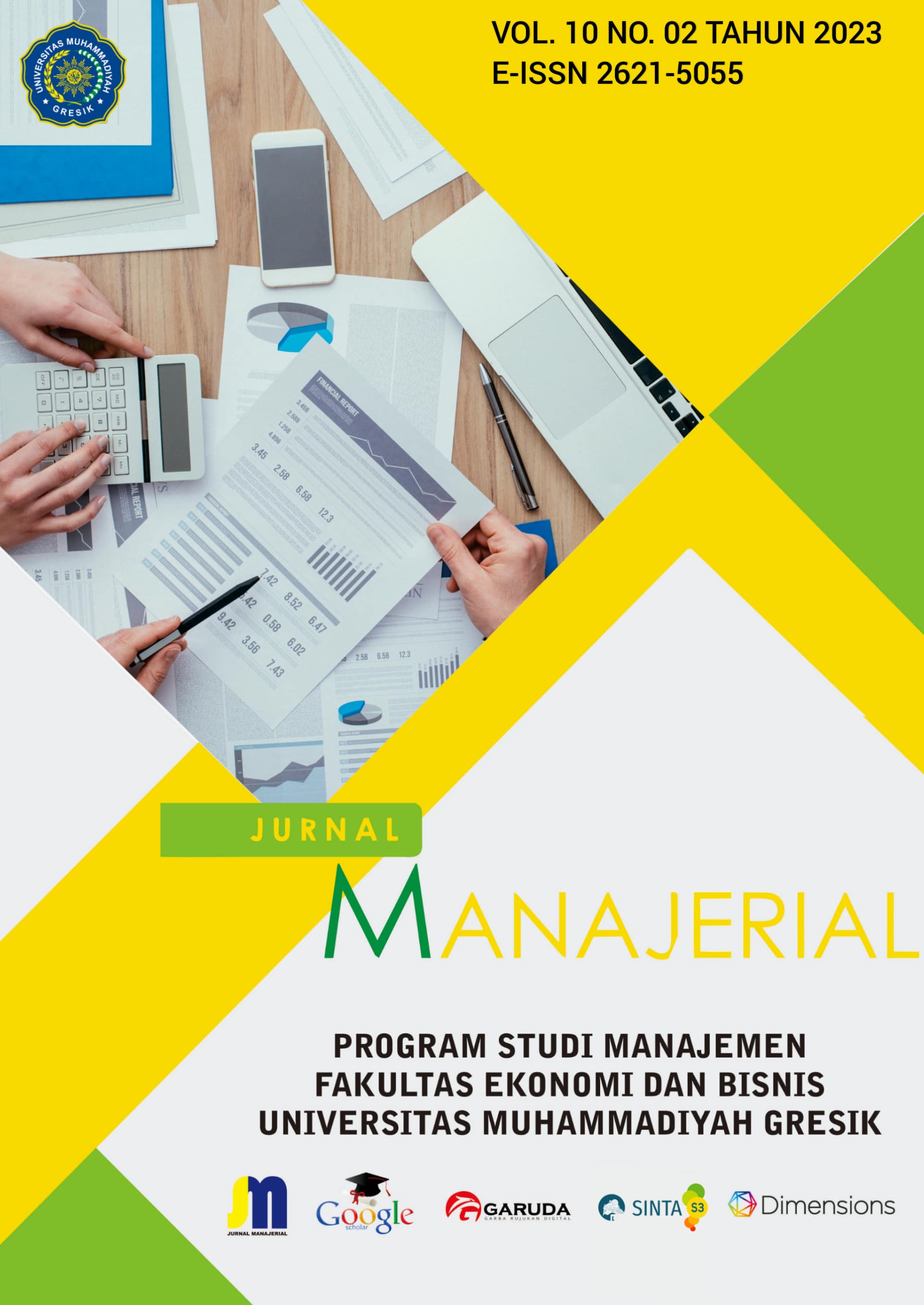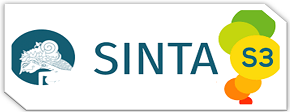Pengaruh Kualitas Kehidupan Kerja dan Keseimbangan Kehidupan Kerja Terhadap Performa Karyawan: Peran Mediasi Kepuasan Kerja
DOI:
https://doi.org/10.30587/jurnalmanajerial.v10i02.5363Keywords:
Quality, Work, Life, Balance, Satisfaction, PerformanceAbstract
Background – The relationship between work and personal life has been the subject of research of interest to academics and practitioners at the moment. Job conditions, work patterns, and demands have been drivers of reform, changes in demographic composition, and labor market evolution. The number of working hours, methods of regulating working hours, as well as the availability of rest periods significantly affect the quality of work and workers' lives. The phenomenon of Great Resignation has also increased after the Covid-19 pandemic as an indication that the issue of work-life balance is the main discussion of social and labor market problems. Environmental adjustments and flexibility of working hours are considered capable of driving current business performance .
Aim – The purpose of this research is to determine the effect of quality of work life and work-life balance on employee performance with job satisfaction as a moderation variable.
Design/ Methodology/ Approach – This research uses a quantitative approach with survey methods to obtain data from respondents.
Findings – The results of this research show that the quality of work life and work-life balance have a positive and significant effect on job satisfaction and employee performance. While the direct relationship between job satisfaction and job performance did not have a significant effect, so the role of mediating variables of job satisfaction did not occur. These results show that employees do not enjoy good job satisfaction, but the impact does not motivate employees to contribute more to their work. This is very bad because employees are not motivated to develop and maximize work performance. The results of this study are expected to provide input for companies to improve the quality of work life and work-life balance of employees so as to improve the work performance of employees. Its employees will therefore be compressed on the company’s overall productivity.
Conclusion – Stakeholders must pay attention to quality of work life and work-life balance to maintain job satisfaction and ultimately promote sustainable employee performance.
Research Implications – This research recommends developing a conceptual framework by adding stress, burnout, remuneration, and work from home factors in the digital age.
Limitations of Research – This research is only limited to the point of view of the woman, not to include the point of view of the organization.
References
Akinlade, O. C., & Nwaodike, C. A. (2021). Work Life Balance and Job Satisfaction of Employees in Murtala Muhammed and Victor Attah International Airports in Nigeria. KIU Journal of Social Sciences, 7(2), 111–120.
Aminizadeh, M., Saberinia, A., Salahi, S., Sarhadi, M., Jangipour Afshar, P., & Sheikhbardsiri, H. (2022). Quality of working life and organizational commitment of Iranian pre-hospital paramedic employees during the 2019 novel coronavirus outbreak. International Journal of Healthcare Management, 15(1), 36–44.
Aruldoss, A., Berube Kowalski, K., Travis, M. L., & Parayitam, S. (2022). The relationship between work–life balance and job satisfaction: Moderating role of training and development and work environment. Journal of Advances in Management Research, 19(2), 240–271.
Aruldoss, A., Kowalski, K. B., & Parayitam, S. (2021). The relationship between quality of work life and work-life-balance mediating role of job stress, job satisfaction and job commitment: evidence from India. Journal of Advances in Management Research, 18(1), 36–62.
Brough, P., Timms, C., O’Driscoll, M. P., Kalliath, T., Siu, O.-L., Sit, C., & Lo, D. (2014). Work–life balance: A longitudinal evaluation of a new measure across Australia and New Zealand workers. The International Journal of Human Resource Management, 25(19), 2724–2744.
Cao, X., Guo, X., Vogel, D., & Zhang, X. (2016). Exploring the influence of social media on employee work performance. Internet Research.
Cascio, W. F. (1998). The future world of work: Implications for human resource costing and accounting. Journal of Human Resource Costing & Accounting, 3(2), 9–19.
Chandranshu, S. (2012). Factors affecting quality of work life: empirical evidence from Indian organizations. Australian Journal of Business and Management Research, 1(11), 31–40.
Cohen, J. (2013). Statistical power analysis for the behavioral sciences. Routledge.
Donaldson, S. I., Sussman, S., Dent, C. W., Severson, H. H., & Stoddard, J. L. (1999). Health behavior, quality of work life, and organizational effectiveness in the lumber industry. Health Education & Behavior, 26(4), 579–591.
Dousin, O., Collins, N., & Kler, B. K. (2019). Work-life balance, employee job performance and satisfaction among doctors and nurses in Malaysia. International Journal of Human Resource Studies, 9(4), 306–319.
Eliyana, A., & Ma’arif, S. (2019). Job satisfaction and organizational commitment effect in the transformational leadership towards employee performance. European Research on Management and Business Economics, 25(3), 144–150.
Falk, R. F., & Miller, N. B. (1992). A primer for soft modeling. University of Akron Press.
Farid, A., Haerani, S., Hamid, N., & Reni, A. (2019). The Effect of Organizational Culture, Organizational Commitment and Work Satisfaction Toward Teacher Performance of High School at Makassar. Hasanuddin Journal of Applied Business and Entrepreneurship, 2(2), 89–99.
Fornell, C., & Larcker, D. F. (1981). Structural equation models with unobservable variables and measurement error: Algebra and statistics. Sage Publications Sage CA: Los Angeles, CA. https://doi.org/https://doi.org/10.1177/002224378101800313
Foy, T., Dwyer, R. J., Nafarrete, R., Hammoud, M. S. S., & Rockett, P. (2019). Managing job performance, social support and work-life conflict to reduce workplace stress. International Journal of Productivity and Performance Management, 68(6), 1018–1041.
Haar, J. M. (2013). Testing a new measure of work–life balance: A study of parent and non-parent employees from New Zealand. The International Journal of Human Resource Management, 24(17), 3305–3324.
Haider, S., Jabeen, S., & Ahmad, J. (2018). Moderated mediation between work life balance and employee job performance: The role of psychological wellbeing and satisfaction with coworkers. Revista de Psicología Del Trabajo y de Las Organizaciones, 34(1), 29–37.
Hair, J. F., Ringle, C. M., & Sarstedt, M. (2011). PLS-SEM: Indeed a silver bullet. Journal of Marketing Theory and Practice, 19(2), 139–152.
Hair, J. F., Sarstedt, M., Ringle, C. M., & Mena, J. A. (2012). An assessment of the use of partial least squares structural equation modeling in marketing research. Journal of the Academy of Marketing Science, 40, 414–433.
Hair Joe F, J., Sarstedt, M., Matthews, L. M., & Ringle, C. M. (2016). Identifying and treating unobserved heterogeneity with FIMIX-PLS: part I–method. European Business Review, 28(1), 63–76.
Henseler, J., Ringle, C. M., & Sarstedt, M. (2015). A new criterion for assessing discriminant validity in variance-based structural equation modeling. Journal of the Academy of Marketing Science, 43, 115–135.
Hewagama, G., Boxall, P., Cheung, G., & Hutchison, A. (2019). Service recovery through empowerment? HRM, employee performance and job satisfaction in hotels. International Journal of Hospitality Management, 81, 73–82.
ilo.org. (2023). Working Time and Work-Life Balance Around the World. https://www.ilo.org/global/publications/books/WCMS_864222/lang--en/index.htm
Johari, J., Tan, F. Y., & Zulkarnain, Z. I. T. (2018). Autonomy, workload, work-life balance and job performance among teachers. International Journal of Educational Management.
Judge, T. A., Bono, J. E., Erez, A., & Locke, E. A. (2005). Core self-evaluations and job and life satisfaction: the role of self-concordance and goal attainment. Journal of Applied Psychology, 90(2), 257.
Kim, W. G., Leong, J. K., & Lee, Y.-K. (2005). Effect of service orientation on job satisfaction, organizational commitment, and intention of leaving in a casual dining chain restaurant. International Journal of Hospitality Management, 24(2), 171–193.
Kreitner, R., & Kinicki, A. (2003). Perilaku Organisasi, Dalam: early suandy (penterjemah). Jakarta: Salemba Empat.
Kuvaas, B. (2006). Performance appraisal satisfaction and employee outcomes: mediating and moderating roles of work motivation. The International Journal of Human Resource Management, 17(3), 504–522.
Leitão, J., Pereira, D., & Gonçalves, Â. (2019). Quality of work life and organizational performance: Workers’ feelings of contributing, or not, to the organization’s productivity. International Journal of Environmental Research and Public Health, 16(20), 3803.
Mensah, J. K. (2015). A “coalesced framework” of talent management and employee performance: For further research and practice. International Journal of Productivity and Performance Management.
Nauman, S., Malik, S. Z., Saleem, F., & Ashraf Elahi, S. (2023). How emotional labor harms employee’s performance: unleashing the missing links through anxiety, quality of work-life and Islamic work ethic. The International Journal of Human Resource Management, 1–31.
Pamungkas, Y. (2016). Pengaruh Kualitas Kehidupan Kerja Terhadap Kinerja Dengan Kepuasan Dan Disiplin Kerja Sebagai Variabel Intervening (Studi Pada Karyawan Bps Provinsi DI Yogyakarta). JBTI: Jurnal Bisnis: Teori Dan Implementasi, 7(2), 221–250.
Perera, G. D. N., Khatibi, A., Navaratna, N., & Chinna, K. (2014). Job satisfaction and job performance among factory employees in apparel sector. Asian Journal of Management Sciences & Education, 3(1), 96–104.
Podsakoff, P. M., MacKenzie, S. B., Lee, J.-Y., & Podsakoff, N. P. (2003). Common method biases in behavioral research: a critical review of the literature and recommended remedies. Journal of Applied Psychology, 88(5), 879.
Podsakoff, P. M., & Organ, D. W. (1986). Self-reports in organizational research: Problems and prospects. Journal of Management, 12(4), 531–544.
Robbins, S. P. (2001). Perilaku Organisasi: konsep, konrtoversi, aplikasi.
Roberts, J. A., & David, M. E. (2020). Boss phubbing, trust, job satisfaction and employee performance. Personality and Individual Differences, 155, 109702.
Setyaningrum, R. P., & Ekhsan, M. (2021). The Role Of Job Satisfaction In Mediating The Influence Of Quality Of Work Life On Employee Performance. Management Research Studies Journal, 2(1), 44–54.
Sohrabi, M. S., & Babamiri, M. (2022). Effectiveness of an ergonomics training program on musculoskeletal disorders, job stress, quality of work-life and productivity in office workers: a quasi-randomized control trial study. International Journal of Occupational Safety and Ergonomics, 28(3), 1664–1671.
Soomro, A. A., Breitenecker, R. J., & Shah, S. A. M. (2018). Relation of work-life balance, work-family conflict, and family-work conflict with the employee performance-moderating role of job satisfaction. South Asian Journal of Business Studies, 7(1), 129–146.
Spector, P. E. (1997). Job satisfaction: Application, assessment, causes, and consequences (Vol. 3). Sage.
Tamunomiebi, M. D., & Oyibo, C. (2020). Work-life balance and employee performance: A literature review. European Journal of Business and Management Research, 5(2).
Wirastuti, S., Eryanto, H., Susono, J., & Amiruddin, K. (2020). The Effect of Work Load and Quality Work Life on the Performance of Police Members in Indonesian Police Headquarters Korlantas with Job Satisfaction as Intervening Variables. International Journal on Advanced Science, Education, and Religion, 3(4), 142–163.






























 P-ISSN: 2354-8592 __ E-ISSN: 2621-5055
P-ISSN: 2354-8592 __ E-ISSN: 2621-5055 
